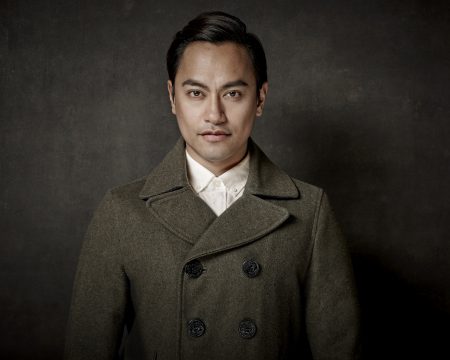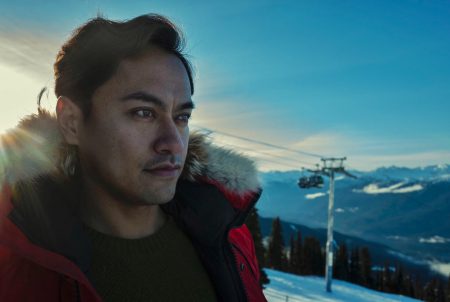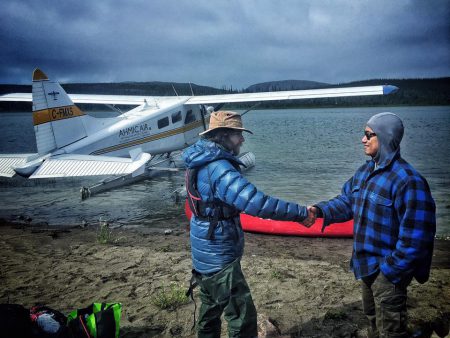2.5K
 FL: Shooting the film, I heavily relied on Adam to capture the Arctic as he really was alone in the middle chunk of the film. I only received the first batch of the expedition footage from the supply drop at the Coppermine River which was the halfway point of the journey, when we exchanged memory cards. After reviewing the footage I was only really able to determine how to direct him moving forward on what to do, what to shoot and what to express via satellite phone. It was a challenging and unique way of directing a film for sure, but that’s also what makes it special. At the end of the day, at the time, finishing the journey was Adam’s top priority and so I’ve had to make concessions being so low in his priority list. But that’s where the filmmaking aspect came into play; without the supplementary elements it wouldn’t be a film.
FL: Shooting the film, I heavily relied on Adam to capture the Arctic as he really was alone in the middle chunk of the film. I only received the first batch of the expedition footage from the supply drop at the Coppermine River which was the halfway point of the journey, when we exchanged memory cards. After reviewing the footage I was only really able to determine how to direct him moving forward on what to do, what to shoot and what to express via satellite phone. It was a challenging and unique way of directing a film for sure, but that’s also what makes it special. At the end of the day, at the time, finishing the journey was Adam’s top priority and so I’ve had to make concessions being so low in his priority list. But that’s where the filmmaking aspect came into play; without the supplementary elements it wouldn’t be a film.
To mark Canada’s 150th birthday in 2017, explorer Adam Shoalts set out to cross the Canadian Arctic in a race against time that lasted four months, 4000 kilometres, with no rifle, on foot and by canoe. Director/Writer Francis Luta captures Adam’s journey in Alone Across the Arctic (2019), a documentary which is composed of Adam’s own shots of the mountains, rivers, tundra, forest and waterways he encountered on his solo trek in addition to other cinematography work. Alone Across the Arctic won the Best Documentary at the Gold Movie Awards and has been nominated for Best Documentary Cinematography (Canadian Society of Cinematographers Awards) as well as Best Canadian Documentary (Hollywood North Film Awards).
Ricepaper’s JF Garrard had a chance to catch up with Francis Luta as Alone Across the Arctic premiered on AppleTV+ as part of their top Earth Day documentary line-up and will also be a part of the Canadian Film Fest 2020.
JF Garrard (JFG): When we look up your bio, the internet tells us that you wear many hats from writing to directing to producing. You’re also an artist, as some of the animal artwork in “Alone Across the Arctic” was drawn by you! Can you tell us a little bit about where you grew up, how your family influenced you and how you ended being a documentarian?
Francis Luta (FL): I was born in Manila Philippines, then ten years later my mum uprooted us to Canada. Scarborough was my ol’ stomping grounds and knew at a very early age that I loved the arts which eventually grew to the need to somehow be involved with moving pictures—film. My family was my biggest influencer when it came to what I wanted to do in life. They still influence me. We are all artists, we can all draw but I’m the only one that stuck to it in deciding that this is what I’m going to do in life. Being a documentarian is a path I didn’t ever think I would take, but that’s the beauty of it all; sometimes the path you’re on will take you to some unexpected inlets and I’ve learned to equip myself with everything I’ve learned up to this point and face it head on.
JFG: Why did you choose to capture Adam Shoalts’ expedition across the Arctic and how did this project come about?
FL: In some ways the expedition chose me. It all starts with short films. Filmmakers make short films in hopes to make a larger project down the line. Adam and I made a short film five years ago called Explorer, it’s an introductory short film about his persona and his mandate as a modern-day explorer. Having that under our belts it was only a matter of time for him to invite me to make a feature film about his next big expedition which is what Alone Across the Arctic is all about. You don’t get an invite like that every day so I took it on knowing that everything I have been preparing for up to this point will all come into play in making my first feature film.
JFG: In the film, Adam mentions he planned the trip for 3 years. Was this a similar timeframe for you and what type of activities did you have to do to plan for this project?
FL: I only had a couple of months to prepare for the film as Adam was going on the expedition whether there was a film or not. I didn’t have the same luxury of over-preparing and obsessing over every detail as I had to assemble my team, pitch it to producers and cinematographers to come on board with me for this. That’s part of it, you have to sell the project to the crew for little-to-nothing because when you’re starting out and networks aren’t interested, your project falls under the “Passion Project” category and you make it on your own. The planning consisted of studying the map of northern Canada and understanding Adam’s route, as well as the logistics of the supply drop off points and exactly how to get to these remote places. Adam had his own expedition covered so my responsibility was the filmmaking aspect: working with talented cinematographers (Mike Reid, Martin Wojtunik and Jeremy Benning csc) on how to capture the bookends of the film, interviews, aerial shots and other supplementary footage as well as training Adam how to use the camera because once he sets foot in the Arctic and hopped in his trusted red canoe, he is indeed alone.
JFG: What type of equipment did you and Adam use? Were drones or helicopters used for the beautiful aerial shots?
FL: Adam used the Sony AX100 as well as GoPros. He shot all of the middle chunk of the expedition himself and I think he did a great job. It was a challenge at first to convince him to use a 4k camera but we didn’t give him a choice as we needed him to use a camera that will give us the best footage in order to meet the criteria of streaming platforms. The epic aerial shots were captured with the DJI Inspire II which was done at the drop off point in the Yukon Territory by Martin Wojtunik, then at the supply drop several weeks later in Northwest Territories by Pablo Saravanja, then at the end point in Nunavut by Mike Reid. I took aerial elements from the short film Explorer to supplement the beginning of the film which was captured by Tom Comet and Jeremy Benning csc. I myself used the Canon XC10 as the B-roll camera, which was given to me by Canon Canada after making a short film produced by Canon called Vivid.
JFG: Some of the most painful scenes was watching Adam carry his supplies and canoe back and forth when faced with physical hurdles. Can you describe what fueled him, or his diet for his journey? (Note to Ricepaper readers, we learned that spruce tree leaves boiled in water = spruce tea and its high amount of Vitamin C can prevent scurvy. But JFG never plans to enter the wilderness to camp and will forget this fact now!)
FL: Yes indeed. I learned that as well the first time watching the footage in my editing suite when Adam talked about where to get your source of Vitamin C in the middle of the Arctic. Adam doesn’t believe in killing as he didn’t pack a gun with him. He didn’t even fish. He wanted to travel as light as possible and to keep his expedition as non-disruptive to the land as possible. So he ate mostly power bars, granola bars, nuts, seeds and freeze-dried meals. There are times when he didn’t even eat as his sole focus was to get to the finish line. By the end, Adam gifted me with his left-over granola bars which came in handy during the long flight home from the end point of the journey in Nunavut.
JFG: Can you explain why Adam chose the route he took and did you take part in travelling for any of it? At one point a bush plane drops off supplies, given Adam didn’t have contact with anyone in a while, we wondered if the scene with Adam and whoever dropped off the supplies would have been interesting. Or perhaps such a scene would have interrupted the flow of the solo journey? We presumed he didn’t see any other travellers on his journey?
FL: The expedition route is an amalgamation of the routes taken by Explorers of the past, Adam stitched it together in one long line and took it upon himself to do it in one season. Much like Explorers from centuries ago, they are driven by the need to be one with nature, to inspire and to make something out of themselves and be the first to do it. It’s hard to admit that, but that is a big part of it. We all want to do something big when we feel we are at our utmost prime. I only took part at the drop off point in the Yukon Territory along with my skeleton Expedition Support crew, then again at the supply drop in the middle chunk of the journey where I flew via bush plane to Adam’s coordinates along the Coppermine River in Northwest Territories and finally at the finish line in Baker Lake Nunavut. It was a conscious creative decision not to include much of the supply drop footage in the middle portion of the journey which really only lasted about three hours. I didn’t want to over-populate Adam’s mindset as I wanted him to keep focus on the task at hand. At the same time I wanted the audience to feel the remote and lonely aspect of the journey but also staying true enough to include a bit of the exchange, by seeing the bush plane land on the freezing waters of the Coppermine River, to show the honesty of needing a bit of lifeline in order for Adam to complete such a feat. I’ve compiled the Expedition Support filmmaker’s perspective into a short film which will be available on Apple TV’s bonus feature for the film. Adam discusses his other unique encounters in his book Beyond The Trees: A Journey Alone Across Canada’s Arctic.
JFG: Adam shot a lot of footage. What criteria did you use to pick the scenes to tell the story?
FL: Part of what makes the film unique and obsessed with realism is the chronological order of telling the story. There are no tricks, no gimmicks, no fancy rearrangement, no unnecessary stunts, no red herrings— it’s told in real time, just as it unfolded right before his eyes.
JFG: What was the most difficult issue you faced when shooting ‘Alone Across the Arctic’?
 FL: Shooting the film, I heavily relied on Adam to capture the Arctic as he really was alone in the middle chunk of the film. I only received the first batch of the expedition footage from the supply drop at the Coppermine River which was the halfway point of the journey, when we exchanged memory cards. After reviewing the footage I was only really able to determine how to direct him moving forward on what to do, what to shoot and what to express via satellite phone. It was a challenging and unique way of directing a film for sure, but that’s also what makes it special. At the end of the day, at the time, finishing the journey was Adam’s top priority and so I’ve had to make concessions being so low in his priority list. But that’s where the filmmaking aspect came into play; without the supplementary elements it wouldn’t be a film.
FL: Shooting the film, I heavily relied on Adam to capture the Arctic as he really was alone in the middle chunk of the film. I only received the first batch of the expedition footage from the supply drop at the Coppermine River which was the halfway point of the journey, when we exchanged memory cards. After reviewing the footage I was only really able to determine how to direct him moving forward on what to do, what to shoot and what to express via satellite phone. It was a challenging and unique way of directing a film for sure, but that’s also what makes it special. At the end of the day, at the time, finishing the journey was Adam’s top priority and so I’ve had to make concessions being so low in his priority list. But that’s where the filmmaking aspect came into play; without the supplementary elements it wouldn’t be a film.JFG: What’s the next project you are working on?
FL: I’m in early talks with Adam on what we are going to do next, given the early success of the film; being number one on iTunes, certainly made us think about how to follow-up with another project to keep the momentum going. I am open and looking for co-producing partners and networks to fund my next project —we have Alone Across The Arctic to prove what we can do on our own, so you can only imagine what we can do with bigger means and time on our side during this pandemic.
JFG: Thank you for your time! Good luck on your film making journey and all of us look forward to watching your future works!


1 comment
This is really interesting, just saw the trailer, look forward to streaming the doc.